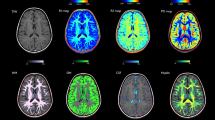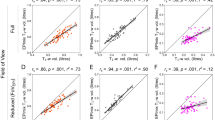Abstract
Purpose
This retrospective study aimed to explore age-related atrophy of the mammillary bodies (MBs) based on their temporal change using magnetic resonance imaging (MRI).
Materials and methods
The study included 30 adult outpatients who presented to the hospital and were followed for more than 100 months with annual MRIs. The bi-ventricular width (BVW), third ventricle width (TVW), and bi-mammillary dimension (BMD) were measured on axial T2-weighted imaging and analyzed.
Results
The 30 patients comprised 1 in their 40s, 5 in their 50s, 6 in their 60s, 11 in their 70s, 5 in their 80s, and 2 in their 90s. The MBs were consistently detected with left-to-right symmetry. The mean BVW was 32 ± 2.2 mm on the initial (BVW1) and 32 ± 2.4 mm on the last (BVW2) MRI. The mean TVW was 7.0 ± 2.3 mm on the initial (TVW1) and 7.6 ± 2.7 mm on the last (TVW2) MRI. Furthermore, the mean BMD was 9.9 ± 1.3 mm on the initial (BMD1) and 10 ± 1.3 mm on the last (BMD2) MRI. Statistically, no age ranges had a large dimension for BVW1, BVW2, TVW1, TVW2, BMD1, or BMD2. Changes between TVW1 and TVW2 were significantly different in the patients in their 80s; changes between BMD1 and BMD2 were not different for any age range or between sexes.
Conclusions
Aging alone does not seem to promote MB atrophy. In healthy brains, the MBs may be stationary structures throughout life.




Similar content being viewed by others
Availability of data and materials
The data and materials used in this study are available from the corresponding author upon reasonable request (Satoshi Tsutsumi).
References
Balak N, Balkuv E, Karadag A, Basaran R, Biceroglu H, Erkan B, Tanriover N (2018) Mammillothalamic and mammillotegmental tracts as new targets for dementia and epilepsy treatment. World Neurosurg 110:133–144. https://doi.org/10.1016/j.wneu.2017.10.168
Bernstein HG, Klix M, Dobrowolny H, Brisch R, Steiner J, Bielau T, Gos T, Bogerts B (2012) A postmortem assessment of mammillary body volume, neuronal number and densities, and fornix volume in subjects with mood disorders. Eur Arch Psychiatry Clin Neurosci 262:637–646. https://doi.org/10.1007/s00406-012-0300-4
Ghaderi Niri S, Khalaf AM, Massoud TF (2020) The mammillothalamic tracts: age-related conspicuity and normative morphometry on brain magnetic resonance imaging. Clin Anat 33:911–919. https://doi.org/10.1002/ca.23595
Gibo H, Marinkovic S, Brigante L (2001) The microsurgical anatomy of the premammillary artery. J Clin Neurosci 8:256–260. https://doi.org/10.1054/jocn.2000.0822
Guillery RW (1955) A quantitative study of the mammillary bodies and their connexions. J Anat 89:19–32
Henry-Feugeas MC, Azouvi P, Fontaine A, Denys P, Bussel B, Maaz F, Samson Y, Schouman-Claeys E (2000) MRI analysis of brain atrophy after severe closed-head injury: relation to clinical status. Brain Inj 14:597–604. https://doi.org/10.1080/02699050050043962
Iaccarino C, Tedeschi E, Rapanà A, Massarelli I, Belfiore G, Quarantelli M, Bellotti A (2009) Is the distance between mammillary bodies predictive of a thickened third ventricle floor? J Neurosurg 110:852–857. https://doi.org/10.3171/2008.4.17539
Khalsa SS, Kumar R, Patel V, Strober M, Feusner JD (2016) Mammillary body volume abnormalities in anorexia nervosa. Int J Eat Disord 49:920–929. https://doi.org/10.1002/eat.22573
Kinoshita F, Kinoshita T, Toyoshima H, Shinohara Y (2019) Ipsilateral atrophy of the mammillary body and fornix after thalamic stroke: evaluation by MRI. Acta Radiol 60:1512–1522. https://doi.org/10.1177/0284185119839166
Kumar Manda P, Kumar Yadav S, Anand Saraswat V, Kumar Singh J, Upreti P, Singh R, Kishore Singh Rathore R, Kumar Gupta R (2009) Mammillary body atrophy in acute liver failure and acute-on-chronic liver failure of nonalcoholic etiology. Metab Brain Dis 24:361–371. https://doi.org/10.1007/s11011-009-9140-y
Kumar R, Birrer BV, Macey PM, Woo MA, Gupta PK, Yan-Go FL, Harper RM (2008) Reduced mammillary body volume in patients with obstructive sleep apnea. Neurosci Lett 438:330–334. https://doi.org/10.1016/j.neulet.2008.04.071
Kumar R, Woo MA, Birrer BV, Macey PM, Fonarow GC, Hamilton MA, Harper RM (2009) Mammillary bodies and fornix fibers are injured in heart failure. Neurobiol Dis 33:236–242. https://doi.org/10.1016/j.nbd.2008.10.004
Mamourian AC, Rodichok L, Towfighi J (1995) The asymmetric mammillary body: association with medial temporal lobe disease demonstrated with MR. AJNR Am J Neuroradiol 16:517–522
Marinković S, Milisavljević M, Kovacević M (1986) Interpeduncular perforating branches of the posterior cerebral artery. Microsurgical anatomy of their extracerebral and intracerebral segments. Surg Neurol 26:349–359. https://doi.org/10.1016/0090-3019(86)90135-7
Markov NT, Lindbergh CA, Staffaroni AM, Perez K, Stevens M, Nguyen K, Murad NF, Fonseca C, Campisi J, Kramer J, Furman D (2022) Age-relayed brain atrophy is not a homogenous process: Different functional brain networks associate differentially with aging and blood factors. Proc Natl Acad Sci USA 119:e2207181119. https://doi.org/10.1073/pnas.2207181119
Meys KME, de Vries LS, Groenendaal F, Vann SD, Lequin MH (2022) The mammillary bodies: a review of causes of injury in infants and children. AJNR Am J Neuroradiol 43:802–812. https://doi.org/10.3174/ajnr.A7463
Morishita Y, Mugikura S, Mori N, Tamura H, Sato S, Akashi T, Jin K, Nakasato N, Takase K (2019) Atrophy of the ipsilateral mammillary body in unilateral hippocampal sclerosis shown by thin-slice-reconstructed volumetric analysis. Neuroradiology 61:515–523. https://doi.org/10.1007/s00234-019-02158-4
Ozturk Y, Yousem DM, Mahmood A, El Sayed S (2008) Prevalence of asymmetry of mammillary body and fornix size on MR imaging. AJNR Am J Neuroradiol 29:384–387. https://doi.org/10.3174/ajnr.A0801
Preul C, Hund-Georgiadis M, Forstmann BU, Lohmann G (2006) Characterization of cortical thickness and ventricular width in normal aging: a morphometric study at 3 Tesla. J Magn Reson Imaging 24:513–519. https://doi.org/10.1002/jmri.20665
Raz N, Torres IJ, Acker JD (1992) Age-related shrinkage of the mammillary bodies: in vivo MRI evidence. NeuroReport 3:713–716. https://doi.org/10.1097/00001756-199208000-00016
Salat DH, Buckner RL, Snyder AZ, Greve DN, Desikan RS, Busa E, Morris JC, Dale AM, Fischl B (2004) Thinning of the cerebral cortex in aging. Cereb Cortex 14:721–730. https://doi.org/10.1093/cercor/bhh032
Shah A, Jhawar SS, Goel A (2012) Analysis of the anatomy of the Papez circuit and adjoining limbic system by fiber dissection techniques. J Clin Neurosci 19:289–298. https://doi.org/10.1016/j.jocn.2011.04.039
Sheedy D, Lara A, Garrick T, Harper C (1999) Size of mammillary bodies in health and disease: useful measurements in neuroradiological diagnosis of Wernicke’s encephalopathy. Alcohol Clin Exp Res 23:1624–1628
Tagliamonte M, Sestieri C, Romani GL, Gallucci M, Caulo M (2015) MRI anatomical variants of mammillary bodies. Brain Struct Funct 220:85–90. https://doi.org/10.1007/s00429-013-0639-y
Uchino A, Sawada A, Takase Y, Nomiyama K, Egashira R, Kudo S (2005) Ipsilateral mammillary body atrophy after infarction of the posterior cerebral artery territory: MR imaging. Eur Radiol 15:2312–2315. https://doi.org/10.1007/s00330-005-2780-3
Yamada K, Shrier DA, Rubio A, Yoshiura T, Iwanaga S, Shibata DK, Patel U, Numaguchi Y (1998) MR imaging of the mammillothalamic tract. Radiology 207:593–598. https://doi.org/10.1148/radiology.207.3.9609878
Funding
No funding was received for this study.
Author information
Authors and Affiliations
Contributions
ST conceived the study and wrote the manuscript. NS and HU collected the imaging data. ST and HI analyzed the imaging data.
Corresponding author
Ethics declarations
Conflict of interest
The authors declare no conflicts of interest of a financial or personal nature.
Ethical approval
All procedures in this study were performed in accordance with the ethical standards of an institutional and/or national research committee and the 1964 Declaration of Helsinki and its later amendments or comparable ethical standards.
Informed consent
Written informed consent was obtained from all participants included in the study for their participation and publication of this article.
Additional information
Publisher's Note
Springer Nature remains neutral with regard to jurisdictional claims in published maps and institutional affiliations.
Rights and permissions
Springer Nature or its licensor (e.g. a society or other partner) holds exclusive rights to this article under a publishing agreement with the author(s) or other rightsholder(s); author self-archiving of the accepted manuscript version of this article is solely governed by the terms of such publishing agreement and applicable law.
About this article
Cite this article
Tsutsumi, S., Sugiyama, N., Ueno, H. et al. Do the mammillary bodies atrophy with aging? A magnetic resonance imaging study. Surg Radiol Anat 45, 1419–1425 (2023). https://doi.org/10.1007/s00276-023-03205-9
Received:
Accepted:
Published:
Issue Date:
DOI: https://doi.org/10.1007/s00276-023-03205-9




